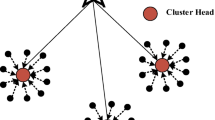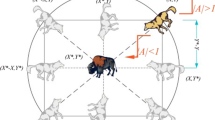Abstract
Wireless sensor networks (WSNs) have gained much attention in public and research communities due to their incredible capabilities and ever-growing range of applications. The WSN is equipped with a specialized transducer that adds the sensing services to IoT. This equipment is limited to battery and resource capacity, which introduces many challenges to academia and industry. Hence WSN has to be utilized in an energy-efficient manner to maximize the network’s lifetime while providing a precise QoS guarantee. QoS is an essential issue in many IoT applications such as environmental monitoring, smart cities, weather monitoring, animal tracking, disaster management, bio-medical applications. An optimal clustering technique for WSN, which includes the formation of clusters, and cluster head (CH) selection, can significantly improve the QoS to increase the lifespan of a WSN. This paper proposes a Grey wolf optimization-based cluster head selection technique for WSN considering distinct factors like energy level of the node, node degree, sink distance, intracluster distance, and priority factor. This paper also addresses the routing through QoS aware relay node selection for effective and reliable inter-cluster routing from CHs to Base station (BS). The proposed technique is simulated and evaluated based on the Quality of Service (QoS) parameters viz. residual energy, stability period, throughput, network lifetime, and delay. The proposed techniques improve the overall network performance by 10.00%, 23.75%, and 54.54% corresponding to ESO, GECR, and LEACH. Hence, the study infers that the protocol is well suited to design WSNs in IoT applications.













Similar content being viewed by others
References
Agrawal D, Wasim Qureshi MH, Pincha P, Srivastava P, Agarwal S, Tiwari V, Pandey S (2020) Gwo-c: Grey wolf optimizer-based clustering scheme for wsns. Int J Commun Syst 33(8):e4344
Ahuja SP, Wheeler N (2020) Architecture of fog-enabled and cloud-enhanced internet of things applications. Int J Cloud Appl Comput (IJCAC) 10(1):1–10
Akyildiz IF, Su W, Sankarasubramaniam Y, Cayirci E (2002) Wireless sensor networks: a survey. Comput Netw 38(4):393–422
Al-Qerem A, Alauthman M, Almomani A, Gupta B (2020) Iot transaction processing through cooperative concurrency control on fog–cloud computing environment. Soft Comput 24(8):5695–5711
Ari AAA, Yenke BO, Labraoui N, Damakoa I, Gueroui A (2016) A power efficient cluster-based routing algorithm for wireless sensor networks: Honeybees swarm intelligence based approach. J Netw Comput Appl 69:77–97
Arjunan S, Sujatha P (2018) Lifetime maximization of wireless sensor network using fuzzy based unequal clustering and aco based routing hybrid protocol. Appl Intell 48(8):2229–2246
Baniata M, Hong J (2017) Energy-efficient unequal chain length clustering for wireless sensor networks in smart cities. Wirel Commun Mob Comput
Bhatia T, Kansal S, Goel S, Verma A (2016) A genetic algorithm based distance-aware routing protocol for wireless sensor networks. Comput Electr Eng 56:441–455
Bozorgi SM, Rostami AS, Hosseinabadi AAR, Balas VE (2017) A new clustering protocol for energy harvesting-wireless sensor networks. Comput Electr Eng 64:233–247
Bulla CM, Birje MN (2021) A multi-agent-based data collection and aggregation model for fog-enabled cloud monitoring. Int J Cloud Appl Comput (IJCAC) 11(1):73–92
Cengiz K, Dag T (2017) Energy aware multi-hop routing protocol for wsns. IEEE access 6:2622–2633
Chen B, Wu Z (2017) Hierarchical clustering routing algorithm based on gray wolf optimization algorithm. 62:1659–1674
Deepa O, Suguna J (2017) An optimized qos-based clustering with multipath routing protocol for wireless sensor networks. J King Saud Univ-Comput Inf Sci 32:763–774
Elhabyan R, Shi W, St-Hilaire M (2018) A pareto optimization-based approach to clustering and routing in wireless sensor networks. J Netw Comput Appl 114:57–69
Elkamel R, Messouadi A, Cherif A (2019) Extending the lifetime of wireless sensor networks through mitigating the hot spot problem. J Parallel Distrib Comput 133:159–169
Fanian F, Rafsanjani MK (2019) Cluster-based routing protocols in wireless sensor networks: a survey based on methodology. J Netw Comput Appl 142:111–142
Feng D, Wu Z, Zhang Z, Fu J (2019) On the conceptualization of elastic service evaluation in cloud computing. J Inf Technol Res (JITR) 12(1):36–48
Gherbi C, Aliouat Z, Benmohammed M (2016) An adaptive clustering approach to dynamic load balancing and energy efficiency in wireless sensor networks. Energy 114:647–662
Gupta B, Quamara M (2020) An overview of internet of things (iot): architectural aspects, challenges, and protocols. Concurr Comput: Pract Exp 32(21):e4946
Hamidouche R, Aliouat Z, Ari AAA, Gueroui M (2019) An efficient clustering strategy avoiding buffer overflow in iot sensors: a bio-inspired based approach. IEEE Access 7:156733–156751
Heinzelman WR, Chandrakasan A, Balakrishnan H (2000) Energy-efficient communication protocol for wireless microsensor networks. In: Proceedings of the 33rd annual Hawaii international conference on system sciences. IEEE, p 10
Jaiswal K, Anand V (2020) Eomr: an energy-efficient optimal multi-path routing protocol to improve qos in wireless sensor network for Iot applications. Wirel Pers Commun 111:2493–2515
Karaboga D, Okdem S, Ozturk C (2012) Cluster based wireless sensor network routing using artificial bee colony algorithm. Wirel Netw 18(7):847–860
Kassan S, Gaber J, Lorenz P (2018) Game theory based distributed clustering approach to maximize wireless sensors network lifetime. J Netw Comput Appl 123:80–88
Kaushik A, Indu S, Gupta D (2019) A grey wolf optimization approach for improving the performance of wireless sensor networks. Wirel Pers Commun 106(3):1429–1449
Kulkarni RV, Venayagamoorthy GK (2010) Particle swarm optimization in wireless-sensor networks: a brief survey. IEEE Trans Syst Man Cybern Part C (Appl Rev) 41(2):262–267
Kumar D, Aseri TC, Patel R (2009) Eehc: energy efficient heterogeneous clustered scheme for wireless sensor networks. Comput Commun 32(4):662–667
Lee J-S, Cheng W-L (2012) Fuzzy-logic-based clustering approach for wireless sensor networks using energy predication. IEEE Sens J 12(9):2891–2897
Liu M, Xu S, Sun S (2012) An agent-assisted qos-based routing algorithm for wireless sensor networks. J Netw Comput Appl 35(1):29–36
Luo L, Li L (2012) An ant colony system based routing algorithm for wireless sensor network. In: 2012 International conference on computer science and electronics engineering, vol 2. IEEE, pp 376–379
Mirjalili S, Mirjalili SM, Lewis A (2014) Grey wolf optimizer. Adv Eng Softw 69:46–61
Mittal N, Singh U, Sohi BS (2017) A novel energy efficient stable clustering approach for wireless sensor networks. Wirel Pers Commun 95(3):2947–2971
Murugan TS, Sarkar A (2018) Optimal cluster head selection by hybridisation of firefly and grey wolf optimisation. Int J Wirel Mob Comput 14(3):296–305
Naranjo PGV, Shojafar M, Mostafaei H, Pooranian Z, Baccarelli E (2017) P-sep: a prolong stable election routing algorithm for energy-limited heterogeneous fog-supported wireless sensor networks. J Supercomput 73(2):733–755
Nigam GK, Dabas C (2018) Eso-leach: Pso based energy efficient clustering in leach. J King Saud Univ-Comput Inf Sci. 1319–1578
Padmavathi DG, Shanmugapriya M et al (2009) A survey of attacks, security mechanisms and challenges in wireless sensor networks. arXiv:0909.0576
Rani S, Ahmed SH, Rastogi R (2020) Dynamic clustering approach based on wireless sensor networks genetic algorithm for Iot applications. Wirel Netw 26:2307–2316
Rehan W, Fischer S, Rehan M, Mawad Y, Saleem S (2020) Qcm2r: a qos-aware cross-layered multichannel multisink routing protocol for stream based wireless sensor networks. J Netw Comput Appl 156:102552
Sabet M, Naji H (2016) An energy efficient multi-level route-aware clustering algorithm for wireless sensor networks: a self-organized approach. Comput Electr Eng 56:399–417
Sahana S, Mukherjee T, Sarddar D (2020) A conceptual framework towards implementing a cloud-based dynamic load balancer using a weighted round-robin algorithm. Int J Cloud Appl Comput (IJCAC) 10 (2):22–35
Sarkar A, Murugan TS (2016) Routing protocols for wireless sensor networks: what the literature says? Alex Eng J 55(4):3173–3183
Stergiou CL, Psannis KE, Gupta BB (2020) Iot-based big data secure management in the fog over a 6g wireless network. IEEE Internet Things J
Tsai C-W, Hong T-P, Shiu G-N (2016) Metaheuristics for the lifetime of wsn: a review. IEEE Sens J 16(9):2812–2831
Verma S, Sood N, Sharma AK (2019) Genetic algorithm-based optimized cluster head selection for single and multiple data sinks in heterogeneous wireless sensor network. Appl Soft Comput 85:105788
Wang J, Cao Y, Li B, Kim H-J, Lee S (2017) Particle swarm optimization based clustering algorithm with mobile sink for wsns. Future Gener Comput Syst 76:452–457
Wang T, Zhang G, Yang X, Vajdi A (2018) Genetic algorithm for energy-efficient clustering and routing in wireless sensor networks. J Syst Softw 146:196–214
Wei Y, Li Q, Gong X, Guo D, Zhang Y (2019) Spectrum prediction and aggregation strategy in multi-user cooperative relay networks. Int J High Perform Comput Netw 13(2):241–250
Yarvis M, Kushalnagar N, Singh H, Rangarajan A, Liu Y, Singh S (2005) Exploiting heterogeneity in sensor networks. In: Proceedings IEEE 24th annual joint conference of the IEEE computer and communications societies, vol 2. IEEE, pp 878–890
Yi D, Yang H (2016) Heer—a delay-aware and energy-efficient routing protocol for wireless sensor networks. Comput Netw 104:155–173
Author information
Authors and Affiliations
Corresponding author
Ethics declarations
Conflict of interest
On behalf of all authors, the corresponding author states that there is no conflict of interest.
Additional information
Publisher’s note
Springer Nature remains neutral with regard to jurisdictional claims in published maps and institutional affiliations.
Rights and permissions
About this article
Cite this article
Jaiswal, K., Anand, V. A Grey-Wolf based Optimized Clustering approach to improve QoS in wireless sensor networks for IoT applications. Peer-to-Peer Netw. Appl. 14, 1943–1962 (2021). https://doi.org/10.1007/s12083-021-01099-1
Received:
Accepted:
Published:
Issue Date:
DOI: https://doi.org/10.1007/s12083-021-01099-1




